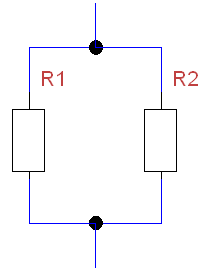2 Resistors in Parallel
Calculator and formula for calculating two resistors in a parallel circuit
2-Resistor Parallel Circuit
Calculation Modes
Calculate either the total resistance from two known resistors or an unknown parallel resistor R₂.
2-Resistor Parallel Circuit

Circuit diagram: Parallel connection of two resistors
Two Calculation Modes
- Calculate total resistance: From R₁ and R₂ → Rtotal
- Calculate parallel resistor R₂: From R₁ and Rtotal → R₂
Product Formula
Special Case
Formulas for Parallel Connection of Two Resistors
1. Calculate total resistance
Product formula for two resistors:
2. Calculate parallel resistor R₂
Rearranged product formula:
3. Derivation via conductances
The product formula can also be derived via conductances (G = 1/R):
Practical Calculation Examples
Example 1: Calculate total resistance
Given: R₁ = 30Ω, R₂ = 20Ω
✓ Check: 12Ω < 20Ω (smallest resistor)
Example 2: Calculate parallel resistor R₂
Given: R₁ = 100Ω, Rtotal = 30Ω
✓ Check: 30Ω < 43Ω < 100Ω
Example 3: Equal resistors (special case)
Special case: When both resistors are equal (R₁ = R₂ = R):
Memory rule: For two equal resistors in parallel, the resistance value is halved.
Current Distribution and Practical Applications
Current Distribution
In a parallel circuit, the total current divides inversely proportional to the resistance values. More current flows through the smaller resistor.
Current Distribution Formulas
Practical Applications
- Reduce resistance values: Reduction of total resistance
- Shunt resistors: Current measurement through parallel resistors
- LED circuits: Series resistors for parallel LED strings
- Bias circuits: Operating point adjustment in amplifiers
- Voltage divider loading: Effects of load currents
Important Notes
- Rtotal is always smaller than the smallest individual resistor
- Total power increases (Ptotal = P₁ + P₂)
- Different currents for different resistors
- Consider load capacity of resistors
Memory Rules
- For equal resistors: Rtotal = R/2
- More current through smaller resistor
- Same voltage across both resistors
- Product formula only for two resistors